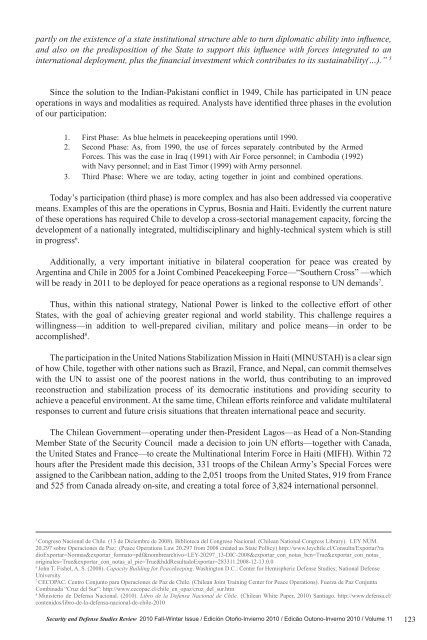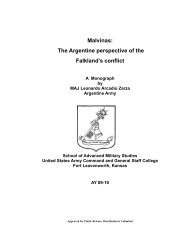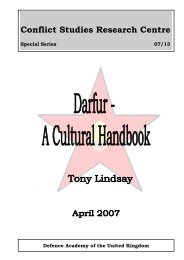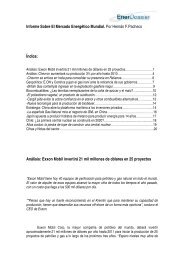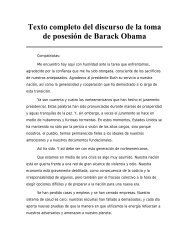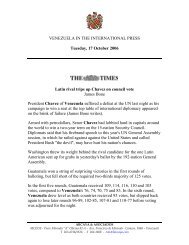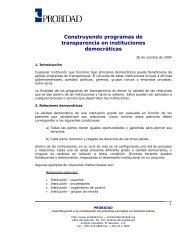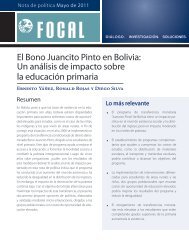Considering this, we will now go from discussing stability <strong>and</strong> invulnerability—referringexclusively to the Nation-State—to emphasizing the freedom, rights <strong>and</strong> security of mankind,communities <strong>and</strong> the world, forcing scholars to think about, <strong>and</strong> weigh the possibility of, balancingnational interests with international obligations.However, the security issue is only part of the problem. From the very beginning of peaceoperations, it was understood that the security achieved after an intervention tended to disappearedif measures were not applied to create an acceptable <strong>and</strong> enduring environment, one that in turngenerated stability <strong>and</strong> security in the conflict zones. Peacekeeping must become Peacebuilding toaccomplish this end. Thus, integral security has long been a basic concept for all the participatingcountries 2 . In fact, international experience demonstrates that States which cooperate in a specificcountry for humanitarian reasons <strong>and</strong> under UN m<strong>and</strong>ate should afterwards complement the peaceoperations of military forces with actions tending to settle the basic needs of the country’s population.To do this, expert personnel from state agencies <strong>and</strong> non-governmental agencies are dispatched toaccomplish these functions. Here, civil society, private sector <strong>and</strong> the business community can allplay a fundamental role.Peace operations as a wider concept represent much more than sending troops. Along with themission of enforcing peace <strong>and</strong> security, they also have a wider <strong>and</strong> more integral multidisciplinarycharacter, dem<strong>and</strong>ing challenges both from civilian <strong>and</strong> military people to act jointly <strong>and</strong> coordinatedin various multiple <strong>and</strong> complex tasks of future operations with the final goal of securing peace.Context of the Chilean ParticipationOne of the key principles that support Chile’s participation in the United Nations is the solidarity withwhich it is guided through concrete <strong>and</strong> coordinated actions taken at a global level. Chilean ForeignPolicy for security stems from a national interest orientation that looks for a great effect of a nationalpower able to grant effective multilateral action. Chile underst<strong>and</strong>s that its integral developmentdepends on the stability <strong>and</strong> security of its immediate geographical environment, as well as of thewhole world 3 .The above constitutes the fundamentals from which the principles that support Chilean actionin peace operations emerge <strong>and</strong> are understood as instruments to preserve international peace <strong>and</strong>security. Therefore, as a contributing nation to international peace <strong>and</strong> stability, it has also evolvedin its relation to peace operations. Its participation with increased force levels has been graduallyencouraged, leading to finally the creation, in 2008, of a new policy framework conceived as aState Policy 4 in the Chilean Parliament, <strong>and</strong> further regulating the national participation in peaceoperations. In this sense, assuming a political leadership, a Peace Operations Commission composedof eight senators—both from the government <strong>and</strong> the opposition—was established. This Commissionpresented a final report that was passed unanimously in the Senate, <strong>and</strong> was then submitted by theExecutive Power as a bill to the Legislature.In order to reassert this position, the 2008 Chilean Peace Operation Law Nº20,297 states that:“The participation in Peace Operation grants Chile international status. Those operations makepossible Chilean participation in a multilateral environment that converges with other states for thepurpose of strengthening the conditions of international peace <strong>and</strong> stability that form part of ournational interest. Within this framework, the capability to be an agent of that convergence depends2David, C.-P. (2006). La Guerre et la Paix: Approches contemporaines de la sécurité et de la stratégie. Paris: Sciences Po.3Ministerio de Relaciones Exteriores; www.minrel.cl. Política Exterior. (Foreign Policy Objectives): http://www.minrel.gov.cl/prontus_minrel/site/artic/20080802/pags/20080802193244.php4Editorial Jurídica de Chile. (1993). Constitución Política de la República de Chile 1980. (1980 Political Constitution of Chile). Santiago: EditorialJurídica de Chile.122<strong>Security</strong> <strong>and</strong> <strong>Defense</strong> <strong>Studies</strong> <strong>Review</strong> <strong>2010</strong> <strong>Fall</strong>-Winter Issue / Edicíón Otoño-Invierno <strong>2010</strong> / Edicão Outono-Inverno <strong>2010</strong> / Volume 11
partly on the existence of a state institutional structure able to turn diplomatic ability into influence,<strong>and</strong> also on the predisposition of the State to support this influence with forces integrated to aninternational deployment, plus the financial investment which contributes to its sustainability(…).” 5Since the solution to the Indian-Pakistani conflict in 1949, Chile has participated in UN peaceoperations in ways <strong>and</strong> modalities as required. Analysts have identified three phases in the evolutionof our participation:1. First Phase: As blue helmets in peacekeeping operations until 1990.2. Second Phase: As, from 1990, the use of forces separately contributed by the ArmedForces. This was the case in Iraq (1991) with Air Force personnel; in Cambodia (1992)with Navy personnel; <strong>and</strong> in East Timor (1999) with Army personnel.3. Third Phase: Where we are today, acting together in joint <strong>and</strong> combined operations.Today’s participation (third phase) is more complex <strong>and</strong> has also been addressed via cooperativemeans. Examples of this are the operations in Cyprus, Bosnia <strong>and</strong> Haiti. Evidently the current natureof these operations has required Chile to develop a cross-sectorial management capacity, forcing thedevelopment of a nationally integrated, multidisciplinary <strong>and</strong> highly-technical system which is stillin progress 6 .Additionally, a very important initiative in bilateral cooperation for peace was created byArgentina <strong>and</strong> Chile in 2005 for a Joint Combined Peacekeeping Force—“Southern Cross” —whichwill be ready in 2011 to be deployed for peace operations as a regional response to UN dem<strong>and</strong>s 7 .Thus, within this national strategy, National Power is linked to the collective effort of otherStates, with the goal of achieving greater regional <strong>and</strong> world stability. This challenge requires awillingness—in addition to well-prepared civilian, military <strong>and</strong> police means—in order to beaccomplished 8 .The participation in the United Nations Stabilization Mission in Haiti (MINUSTAH) is a clear signof how Chile, together with other nations such as Brazil, France, <strong>and</strong> Nepal, can commit themselveswith the UN to assist one of the poorest nations in the world, thus contributing to an improvedreconstruction <strong>and</strong> stabilization process of its democratic institutions <strong>and</strong> providing security toachieve a peaceful environment. At the same time, Chilean efforts re<strong>info</strong>rce <strong>and</strong> validate multilateralresponses to current <strong>and</strong> future crisis situations that threaten international peace <strong>and</strong> security.The Chilean Government—operating under then-President Lagos—as Head of a Non-St<strong>and</strong>ingMember State of the <strong>Security</strong> Council made a decision to join UN efforts—together with Canada,the United States <strong>and</strong> France—to create the Multinational Interim Force in Haiti (MIFH). Within 72hours after the President made this decision, 331 troops of the Chilean Army’s Special Forces wereassigned to the Caribbean nation, adding to the 2,051 troops from the United States, 919 from France<strong>and</strong> 525 from Canada already on-site, <strong>and</strong> creating a total force of 3,824 international personnel.5Congreso Nacional de Chile. (13 de Diciembre de 2008). Biblioteca del Congreso Nacional. (Chilean National Congress Library). LEY NÚM.20.297 sobre Operaciones de Paz: (Peace Operations Law 20.297 from 2008 created as State Pollicy) http://www.leychile.cl/Consulta/Exportar?radioExportar=Normas&exportar_formato=pdf&nombrearchivo=LEY-20297_13-DIC-2008&exportar_con_notas_bcn=True&exportar_con_notas_originales=True&exportar_con_notas_al_pie=True&hddResultadoExportar=283311.2008-12-13.0.06John T. Fishel, A. S. (2008). Capacity Building for Peacekeeping. Washington D.C.: Center for Hemispheric <strong>Defense</strong> <strong>Studies</strong>; National <strong>Defense</strong>University7CECOPAC. Centro Conjunto para Operaciones de Paz de Chile. (Chilean Joint Training Center for Peace Operations). Fuerza de Paz ConjuntaCombinada “Cruz del Sur”: http://www.cecopac.cl/chile_en_opaz/cruz_del_sur.htm8Ministerio de Defensa Nacional. (<strong>2010</strong>). Libro de la Defensa Nacional de Chile. (Chilean White Paper, <strong>2010</strong>) Santiago. http://www.defensa.cl/contenidos/libro-de-la-defensa-nacional-de-chile-<strong>2010</strong><strong>Security</strong> <strong>and</strong> <strong>Defense</strong> <strong>Studies</strong> <strong>Review</strong> <strong>2010</strong> <strong>Fall</strong>-Winter Issue / Edicíón Otoño-Invierno <strong>2010</strong> / Edicão Outono-Inverno <strong>2010</strong> / Volume 11 123
- Page 2 and 3:
Security and Defense Studies Review
- Page 4 and 5:
CommentariesSecurity Cooperation Be
- Page 6:
6Security and Defense Studies Revie
- Page 9 and 10:
El espacio de las mujeres en las Fu
- Page 11 and 12:
La organización e institucionaliza
- Page 14 and 15:
encuentra altamente asociada al cam
- Page 16 and 17:
ministerial para la equidad de gén
- Page 19 and 20:
BibliografíaBarrancos, Dora (2007)
- Page 21 and 22:
Anexo IPaísIncorporación Femenina
- Page 23:
Anexo IIMujeres militares sudameric
- Page 26:
Todo un conjunto de cualidades, cap
- Page 29:
500 y durante la Batalla de Sarand
- Page 32 and 33:
miembros de la soberanía de la Nac
- Page 34 and 35:
10 de octubre de ese año, la Compa
- Page 36 and 37:
algunos barcos de apoyo para alberg
- Page 38 and 39:
1.75 metros de altura y como requis
- Page 40 and 41:
de producción sustituyendo al homb
- Page 42 and 43:
y sicológica, no sólo en los ámb
- Page 44 and 45:
La segunda etapa se caracterizó po
- Page 46 and 47:
Sin embargo, las preguntas acerca d
- Page 48 and 49:
La normativa vinculada con la asign
- Page 50 and 51:
conductas que pudieran encuadrarse
- Page 52 and 53:
Género en el marco de las Operacio
- Page 54 and 55:
ecordar que las ciencias sociales y
- Page 56 and 57:
56Security and Defense Studies Revi
- Page 58 and 59:
De ese modo nos encontramos con mod
- Page 60 and 61:
escala descendente de la oficialida
- Page 62 and 63:
del total. Debe destacarse que dent
- Page 64 and 65:
BibliografíaCarreiras, H.: Gender
- Page 66 and 67:
Tras la aprobación de esta histór
- Page 68 and 69:
Una vez aprobada la Resolución 132
- Page 70 and 71:
para designar asesores de género e
- Page 73 and 74: firme se ha materializado en la ado
- Page 76 and 77: la construcción de la paz, la reco
- Page 78 and 79: Sin embargo, a medida que avanzaba
- Page 81 and 82: Women on the Front Lines of the Fig
- Page 83 and 84: term even has meaning any longer wi
- Page 85 and 86: following graduation. 15 Of course,
- Page 87 and 88: including members from other Americ
- Page 89 and 90: Solidariedade ou interesse? O que l
- Page 91 and 92: em mais amplo e complexo. 7A possib
- Page 93 and 94: Participação dos Estados-Membros
- Page 95: sujeitos a alguma OMP. Aqueles que,
- Page 98 and 99: às recomendações das Fases II, I
- Page 100 and 101: Franco, que assumira após o Impeac
- Page 102 and 103: O Brasil, por intermédio do Presid
- Page 104 and 105: No entanto, no tocante especificame
- Page 106 and 107: Portanto, não se consegue visualiz
- Page 108 and 109: ReferênciasAlmeida Pinto, J.R. de;
- Page 110 and 111: ______. United Nations Department o
- Page 112 and 113: Beyond economic activities, the PRC
- Page 114 and 115: soy oil into the country, a flow wh
- Page 116 and 117: As is the case with Chinese investm
- Page 118 and 119: In some cases, Chinese companies, l
- Page 120 and 121: Although it is not possible to pred
- Page 124 and 125: The contribution of Chilean troops
- Page 126 and 127: within and outside the nation?3. Ho
- Page 128 and 129: 128Security and Defense Studies Rev
- Page 130 and 131: 130Security and Defense Studies Rev
- Page 132 and 133: the Iran-Contra affair, one of the
- Page 134 and 135: all American hostages were released
- Page 136 and 137: “As he frequently said with pride
- Page 138 and 139: making operation 48 was conducted s
- Page 140 and 141: secret army alongside skilled profi
- Page 142 and 143: public than Kelly, taking issue wit
- Page 144 and 145: Some conservatives, even within the
- Page 146 and 147: opponents that he was “getting pr
- Page 148 and 149: for Defense (SUBDEF)—could initia
- Page 150 and 151: Hence, our countries are showing a
- Page 152 and 153: I am referring to Ibero-American Su
- Page 154 and 155: Thus, our country has agreed to the
- Page 156 and 157: sustraer mi producción intelectual
- Page 158 and 159: hombres (22,288).• Inclusión. Al
- Page 160 and 161: La perspectiva de trabajar en el di
- Page 162 and 163: 162Security and Defense Studies Rev
- Page 164 and 165: assignment on the U.S. Secretary of
- Page 166 and 167: las Operaciones de Paz se abren a u
- Page 168 and 169: ConclusiónA modo de conclusión, u
- Page 170 and 171: 170Security and Defense Studies Rev
- Page 172 and 173:
offering insight into political ter
- Page 174 and 175:
goods, and skilled labor must all b
- Page 176 and 177:
country” like North Korea. To be
- Page 178 and 179:
178Security and Defense Studies Rev
- Page 180 and 181:
views of women, in effect disabling
- Page 182 and 183:
Marine Col. William T. Hewes’ arg
- Page 184 and 185:
19. Hughes, Melanie M. (2007) “Un
- Page 186 and 187:
MacEoin. Commonweal 14: 8-11.This i
- Page 188 and 189:
37. Sans Echaìniz, María. (1992)
- Page 190 and 191:
47. Woodward, Rachel, and Patricia
- Page 192 and 193:
elucidativos das dificuldades que e
- Page 194 and 195:
194Security and Defense Studies Rev
- Page 196 and 197:
of an integrated Canadian company i
- Page 198 and 199:
198Security and Defense Studies Rev
- Page 200 and 201:
stated it would rightfully infringe
- Page 202 and 203:
First, through an examination of de
- Page 204 and 205:
204Security and Defense Studies Rev
- Page 206 and 207:
impact on the reader, by acknowledg
- Page 208 and 209:
To the Editor:Kevin P. Newmeyer’s
- Page 210 and 211:
Whitney Hoft was a Center for Hemis
- Page 212 and 213:
The transformation of the role of w
- Page 214 and 215:
en Puerto Rico, esta soldada resume
- Page 216 and 217:
Deconstruyendo a Ollie: Cómo los c
- Page 218:
Center for Hemispheric Defense Stud


